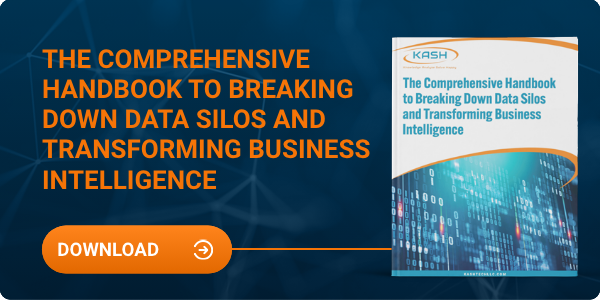3 Amazing Ways Digital Transformation Helps Your Business Thrive
Topic:
Data Silos
So, what is Digital Transformation? According to TechTarget, the quick answer is “the incorporation of computer-based technologies into an organization’s products, processes, and strategies.”
However, that definition is somewhat misleading or at least incomplete. Relying solely on “computer-based technologies” can lead to misunderstanding how Digital Transformation can help your business.
Computer-based technology is critical to your business, but if you expect new technology to transform your business magically, it won’t. Digital Transformation is not simply a technology-focused endeavor.
Digital Transformation is about how you see business, interact with your customers, employees, and suppliers, and how your organization goes to market with your products and services. Migrating from the mindset that computer technology is the be-all, and end-all in achieving Digital Transformation is critical to success. This migration requires a change in perspective and understanding of the role of technology.
The focus of your digital transformation should include:
- establishing a digital mindset
- creating clear and concise communication channels
- promoting a culture of innovation
- integrating applicable technologies
- enhanced data and analytics capabilities
It is true that Digital Transformation helps accelerate the creation and integration of data. But then the question becomes; how do you deliver innovative, creative, and even addictive content for your users? It is this new content and its delivery mechanism which drives better business outcomes!
Curious? Then read on and see how Digital Transformation empowers all users, improves customer engagement, optimizes operations, decreases costs, and increases revenue opportunities for your services and products.
About This Post
In this post, we will cover the following:
- The five core pillars of Digital Transformation
- Digital Transformation is not only about technology
- Technology is a key component, but not the only ingredient in Digital Transformation
- Why digital transformation?
The 5 Core Pillars of Digital Transformation
Before embarking on a Digital Transformation endeavor, it is important to understand the valuable impact that such an initiative will have on your business enterprise. Of equal importance is understanding that by applying the proper coaching and guidance, you can construct a strategy and implement Digital Transformation for your organization.
The five core pillars of Digital Transformation are:
1. A Digital Mindset
According to the Harvard Business Review, a digital mindset is “a set of attitudes and behaviors that enable people and organizations to see how data, algorithms, and AI open up new possibilities and to chart a path for success in an increasingly technology-intensive world.”
2. Staff and Customer Engagement
Clear and concise communication is critical to any initiative. However, when you embark on an end-to-end organization reengineering, such communication is absolutely essential! Embracing transparency and vulnerability is vital to honest, open communications, and your organization must accept this.
3. Culture of Innovation
A culture of innovation thrives on the notion/paradigm that there are no dumb questions or dumb ideas. Free from the pressures of judgment and retaliation, every employee can challenge the status quo and provide unique ideas in a professional manner. A culture of innovation must also provide thoughtful consideration to the questions posed and ideas presented to provide feedback to the community.
4. Technology
“Technology” as used in Digital Transformation may be a misnomer as it encompasses people, processes, and technology (in its traditional definition). However, as with cobots (a collaboration between humans and robots), the line between people, processes, and technology is being blurred. Technology solutions leveraged for Digital Transformation will continue to impact people and processes therefore, these must be seen as a collective for decision-making and planning.
5. Data & Analytics
Digital Transformation is driven by and for the need and ability to collect appropriate and better data, with the main business purpose being the delivery of critical and actionable information in real-time. The goal is to reduce the time-to-decision latency to drive growth and profitability. Additionally, the inherent information feedback loop created is self-sustaining and ensures that your Digital Transformation is constantly improving to keep pace with the changing business ecosystem in which you operate.
Digital Transformation Is Not Only About Technology
This point bears repeating: If you believe technology alone will transform your business, you are missing the target!
While adding technology can support existing business processes and increase efficiencies, it can also disrupt the organization in several ways:
- New technology requires expenditures for software and hardware and implementation services required to install, implement and deploy the technology
- It presents challenges in employee training and adoption
- It can take resources away from core business activities
- User adoption must be managed to achieve the best ROI from the investment
- Long-term sustainment must be properly managed
And the end result, after overcoming these disruptions, is simply digitization, not transformation! So, you’re not there yet.
Nevertheless, Technology is a Key Component of Digital Transformation
The revolution in technology over the last decade has accelerated the Digital Transformation phenomenon. That revolution includes the growth of the cloud, data virtualization, the Internet of Things, mobile computing, analytics, and cobotics.
Each of the foregoing has a place and a role in a fully realized digital transformation strategy. But knowing when, where, why, and how to leverage all that technology is critical to the success of your Digital Transformation journey. It is a journey, not a light switch, and once begun, this journey inspires and drives your business forever!
Why Digital Transformation?
Two simple reasons:
- Because your competitors are doing it! According to Gartner, “91% of businesses are engaged in some form of a digital initiative.” What happens if you don’t?
- Because Digital Transformation will fundamentally change your business model and produce significant value across your organization.
Now, with the foundation laid out above, we can move to the heart of this Blog; 3 Amazing ways Digital Transformation helps your business thrive:
Way #1: Productivity and Profit
For the business owner(s), digital transformation leads to greater productivity and profits. And, of course, businesses do not survive without profit, so this is a true achievable bottom-line benefit to your business.
According to ZIPPIA, The Career Experts:
- 64% of companies with a digital-first strategy are more likely to achieve their business goals than competitors.
- 56% of companies employing Digital Transformation have already improved their profits.
- Digitally mature companies are 23% more profitable than their less mature peers.
Moreover, employee engagement, ownership, collaboration, and accountability are enhanced through a clearer understanding of everyone’s role and impact on the business that comes from the transformation process. This heightened involvement of employees in the business drives efficiency, innovation, and profits.
Way #2: The Focus on Customer Experience
Instead of focusing on reactive problem resolution, digitally transformed organizations have the margin needed to focus on product and service quality, customer experience, and brand storytelling.
Refocusing the organization on those activities results in improved customer satisfaction and loyalty, greater brand awareness, and increased market share, all resulting from making it easier for customers to do business with your organization.
- ZIPPIA also reports that “the top benefits of adopting a digital model are it improves operational efficiency (40%), allows faster time-to-market (36%), and helps meet customer expectations by 35%).
How would those results change your business?
Way #3: Better Data Collection And Analytics
In today’s competitive environment, a business thrives or dies on its ability to handle data. This involves capturing, reporting, and analyzing data that is flowing at lightspeed through the organization. A successful Digital Transformation is a closed-loop system that self-monitors and provides actionable insights. Those insights are critical for the continuous improvement of the enterprise's people, processes, and technology. These improvements then drive the innovation, efficiency, and effectiveness of your enterprise, which in turn produces success.
Therefore, data collection, quality, and democratization are keystones of a Digital Transformation effort Furthermore, they are the foundation of creating a single source of truth and delivering the real-time analytics capabilities required to empower your decision-makers and to realize the true value of Digital Transformation.
Why is Digital Transformation Important to Business?
- Digital Transformation is available, applicable, and adaptable to all business organizations, regardless of size, age, industry, or challenges. Digital Transformation is not simply the application of technology.
- Digital Transformation must encompass the full depth and breadth of your enterprise.
- Your competitors are already doing it. If they can do it, so can you!
- When properly executed, Digital Transformation provides significant value to your organization.
- Digital Transformation requires a partner to provide an outside perspective and a best-of-fit methodology for your specific needs.
- Digital Transformation becomes part of your organizational DNA and thrives on continuous improvement.
Download the handbook to learn how your organization can adopt digital transformation and modernize its business intelligence: The Comprehensive Handbook to Breaking Down Data Silos & Transforming Business Intelligence.
